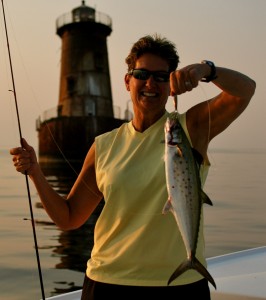 Acelerar, usted está tambaleando demasiado maldito lento. That’s Spanish for “Speed up, you’re reeling too damn slow.” Spanish Mackerel, the fastest fish in the Chesapeake have arrived in good numbers. They’re only in Maryland waters for about a month, but their arrival is something to celebrate.Fishing for Spanish is one of my favorite summer activities. The easiest way to catch them is to troll fast with in-line planers. If I just wanted to put meat in the box, that’s what I’d do. But I prefer to honor these infrequent visitors by targeting them by casting. Mack casting takes Chesapeake Bay fishing to another level. To catch Spaniards you first have to find the blitzing schools of bluefish and stripers, then turn loose of everything you’ve been doing all year, and try not to catch them. Too slow are the words most often heard on Thunder Road when we’re targeting Macks. It means someone onboard has accidentally hooked up a rockfish or a bluefish. When casting for Spanish with light spinning gear, the second most successful cast is one that doesn’t catch a thing.
Acelerar, usted está tambaleando demasiado maldito lento. That’s Spanish for “Speed up, you’re reeling too damn slow.” Spanish Mackerel, the fastest fish in the Chesapeake have arrived in good numbers. They’re only in Maryland waters for about a month, but their arrival is something to celebrate.Fishing for Spanish is one of my favorite summer activities. The easiest way to catch them is to troll fast with in-line planers. If I just wanted to put meat in the box, that’s what I’d do. But I prefer to honor these infrequent visitors by targeting them by casting. Mack casting takes Chesapeake Bay fishing to another level. To catch Spaniards you first have to find the blitzing schools of bluefish and stripers, then turn loose of everything you’ve been doing all year, and try not to catch them. Too slow are the words most often heard on Thunder Road when we’re targeting Macks. It means someone onboard has accidentally hooked up a rockfish or a bluefish. When casting for Spanish with light spinning gear, the second most successful cast is one that doesn’t catch a thing.
Spanish move up the coast from Mexico and Florida in summer months as water temperatures rise. Much more common and easier to catch down south, they reach the Chesapeake Bay in July and August. Some years they come up farther 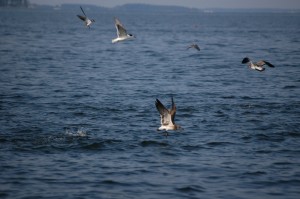 than others, but the Bay Bridge is usually the northernmost edge of their migration. It’s normally Mid-August before they reach the fishing grounds around the Eastern Bay. Every year a few fish show up early, but the bigger schools have just now arrived in the area between Taylor’s Island and Bloody Point in force.
than others, but the Bay Bridge is usually the northernmost edge of their migration. It’s normally Mid-August before they reach the fishing grounds around the Eastern Bay. Every year a few fish show up early, but the bigger schools have just now arrived in the area between Taylor’s Island and Bloody Point in force.
Mackerel are extremely aggressive and great fun to catch. Often you can see them streaking through the water, cutting through the feeding frenzy and zipping past blitzing bluefish and stripers as they pursue your fast-moving lure. Once they’re on, look out! First they’re screaming away from the boat, taking drag and peeling line. Then, in a a split second they’ve turned on a dime and they’re racing back in your direction, leaving so much slack in your line you may never catch up. Hooking a Spanish mackerel is one thing, landing one is something else entirely.
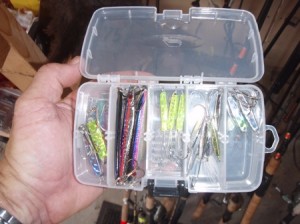 When casting, the object is to get the lure moving so fast that macs are the only fish that can catch up. Macs will hit a lure at any speed, but the object is to get it moving so fast that you can’t catch anything else. You can outrun blues and rockfish, but can’t reel faster than a Spanish Mackerel can swim. I start with a 6′6″ to 7′ spinning rod and a reel that will allow a very fast retrieve. Long limber rods make it easier to cast farther. Spinning reels are usually faster than baitcasters. I use eight or ten pound test braided line. Over-spooling the line on the reel will help because it allows faster line take-up and accelerates the retrieve.
When casting, the object is to get the lure moving so fast that macs are the only fish that can catch up. Macs will hit a lure at any speed, but the object is to get it moving so fast that you can’t catch anything else. You can outrun blues and rockfish, but can’t reel faster than a Spanish Mackerel can swim. I start with a 6′6″ to 7′ spinning rod and a reel that will allow a very fast retrieve. Long limber rods make it easier to cast farther. Spinning reels are usually faster than baitcasters. I use eight or ten pound test braided line. Over-spooling the line on the reel will help because it allows faster line take-up and accelerates the retrieve.
Macks have great eyesight, so I attach 25 pound test fluorocarbon leader and a small flashy lure that is heavy enough to easily cast. Often, a 3/4 ounce inline sinker dressed up with some flash-tape with an attached hook is all you need. Macs will see swivels or snaps, so always tie the leader directly to the lure. If you need a swivel to prevent line twists, put it on above the leader. A thin glass-minnow sized dropper fly tied on above the spoon will increase your chances. I simply cast into the breakers, or toward a mackerel I see jump, and reel like mad.
I’ve been putting off my usual Mid-Bay Spanish runs this summer since 30-inch rockfish are consistently turning up near the bridge, but yesterday I made a trip to the Sharps Island area. My guests on Thunder Road were my wife, her sister Judy, and her friend Karen. We launched off Kent Island and ran south. It’s not hard to find schools of breakers right now, but it can be a challenge to find the ones holding good concentrations of Macks.
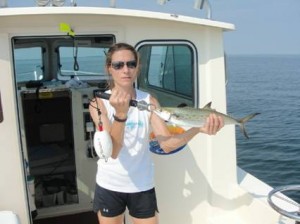
 Fortunately, I had some good intel since my fishing buddy Mark had been out most of the afternoon in his boat. He and his wife Eva had a very good day targeting Spanish and he was nice enough to keep me in the loop. I think they landed five and had about twice that many hooked up. Spanish are pretty common in other parts of the world, but that’s a heck of a day for mack fishing in the Chesapeake Bay.
Fortunately, I had some good intel since my fishing buddy Mark had been out most of the afternoon in his boat. He and his wife Eva had a very good day targeting Spanish and he was nice enough to keep me in the loop. I think they landed five and had about twice that many hooked up. Spanish are pretty common in other parts of the world, but that’s a heck of a day for mack fishing in the Chesapeake Bay.
We found the fish right where Mark and Eva left them. That’s fortunate because these fish move fast. It’s rare to find them at the same place on subsequent days, so they could’ve been long gone. South of Poplar Island we found multiple schools of bluefish with lots of gracefully arching Spanish mixed in. The girls had a blast casting after the jumping fish. Most of their retrieves resulted in fish, but the vast majority were 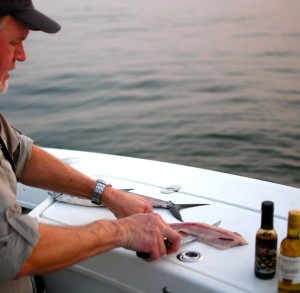 blues in the three to five pound range. There were a few rockfish in the mix, but we didn’t catch too many due to our fast retrieves. Out of the fifty or sixty fish we caught I only counted two stripers.
blues in the three to five pound range. There were a few rockfish in the mix, but we didn’t catch too many due to our fast retrieves. Out of the fifty or sixty fish we caught I only counted two stripers.
We chased the fish until about 7:30 PM then decided to move closer to the lighthouse for some pictures. As we were waiting for the sun to set over Calvert County, I decided to fillet one of the fish. I keep soy sauce and wasabi on the boat this time of year. Spanish are the only fish I’ll eat raw from the Chesapeake. I don’t think they’re in the Bay long enough to pick up a lot of the toxins and bacteria our local fish carry.
For the record, I’m not recommending anyone try this, consuming raw fish can be dangerous, especially in the summer months. It’s a risk I’m willing to take only because it’s my opinion that freshly caught raw Spanish are one of the finest delicacies in the world. After our sunset appetizer, we headed back north toward Kent Island stopping for dinner at Bay Hundred dockside bar & restaurant in Knapps Narrows. We celebrated our successful fishing with tuna sliders and crab soup. Otra margarita por favor. That’s Spanish for “I’ll take another margarita please!”





Shawn;
Excellent article as usual for you. Is the Lighthouse tilted or is that a result of something else? Please don’t tell me a story about an iceberg either.
And that doesn’t look like a Wasabi bottle.
I really enjoy Dianne’s jesture in the last frame. The picture says it all!
Eva and Mark
der Fischadler
great report like always! i hope to be able to get into fish like you
Nice catching! And I think I have just been flipped off.;)
Awesome report, but your Spanish is terrible.
Thanks for sharing Shawn, great stuff as usual. Was out looking for some spanish mac’s on Saturday, just found some breaking schoolies. Same for Sunday evening…
Any tips on identifying if their are MAC’s mixed in when on breakers? Or pretty much just watch closely, and look for ‘darting’ fish skimming across the top?
Looks like south of Poplar is the first key.
Cya out there!
Tony
btw… now owner of a 23′ parker cc!
Shawn,
Thanks for the report, and congratulations. I’m still looking to check that box off, but it’s only a matter of time.
I’m set of to troll than just to get that first one ever in the box, but once spring rockfish season was over, trolling has been a bust for me.
We’ve done well this season LTJ, livelining and bottom fishing but summer trolling has been a bust. Maybe the fishing gods are trying to tell me to turn away from the dark side once and for all.
I should probably try and get my first mac on the jig; it would certainly be much more fun and satisfying than winching in my first one just to say I’ve caught one.
I’d like to get out tomorrow (Thursday) afternoon if the weather permits it. At 2 days past the full moon, I should be able to find some current.
Anyway, congratulations, and thanks for the lesson and inspiration.
Don
PS:
¿Dónde están los Españoles?
¡Yo quiero Españoles!
Enjoyed reading you SM report Shawn. Had a great day on the water today with Jamie, Phil and Dennis. We boated a number of Spanish as they were our target for the day. Can’t wait to get another shot at them next week. Gotta few changes to make, but I will be ready for them. Need to let my reeling hand have a day off after today.
Don